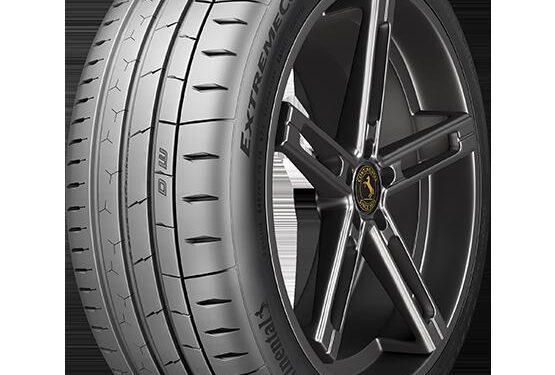Continental’s new flagship max performance summer tire, the Continental ExtremeContact Sport, has been released in the U.S. Here are 8 things to know about what we anticipate will quickly become one of the most desirable tires in category.
1. The ExtremeContact Sport is the successor to the ExtremeContact DW.
The ExtremeContact Sport isn’t Continental’s foray into the world of max performance summer tires. The Continental ExtremeContact DW has been on the market since at least 2009, and remains a go-to tire, and category favorite nearly 8 years later. In the ever-evolving and advancing tire industry, that’s serious staying power.
The ExtremeContact DW is also one of our all-time favorite performance street tires — comfortable, quiet, plenty of grip (for the street), and just superb traction in the wet… We found the DW at its best in monsoon conditions.
ExtremeContact DW shortcomings? Yep, max dry condition traction. Especially as compared to competing tires that followed — most notably the Pilot Super Sport — the ExtremeContact DW couldn’t keep pace in terms of outright traction at the limit, or lap times. So the ExtremeContact Sport has some catching up to do.
The DW also lacked sufficient durability in high performance contexts. After many thousand road miles we killed our set in a single track day. 4-5 HPDE sessions later the DW’s outer shoulders were chunking in a major way. Something that hopefully won’t be a problem with the ExtremeContact Sport because…
2. ExtremeContact Sport sidewall stiffness is reportedly up by some 86% over the DW.
If the ExtremeContact Sport is to offer a tangible improvement in terms of maximum performance, our DW experience indicates that sidewall stiffness/outer shoulder durability will be key. An 86% gain in stiffness should about do it.
Maximum/track performance gains were apparently a primary focus with the ExtremeContact Sport because…
3. These dudes played a key role in ExtremeContact Sport development.
Said dudes are three-time IMSA champion and five-time Rolex 24 Hour winner, Andy Lally; back-to-back, and reigning IMSA champion, Joao Barbosa; Continental Tire SportsCar Series champion and two-time World Challenge champion, Lawson Aschenbach; Rolex 24 Hour winner, Ozz Negri; and 24 Hour of Le Mans winner, Rolex 24 Hour winner and WEC champion, Ryan Dalziel.
The ExtremeContact Sport’s maximum performance capabilities were developed in coordination with this crew. If the ExtremeContact Sport is good enough for them on track, it’ll be good enough for you to enjoy on an occasional track day as well.
4. The ExtremeContact Sport’s 30,000 mile treadlife warranty equals the best in category.
Unlike the ExtremeContact DW, which is sans treadlife warranty, the ExtremeContact Sport comes with a category leading 30,000 mile treadlife warranty. Not coincidentally that mileage figure equals the Michelin Pilot Super Sport and competing Michelin Pilot Sport 4 S.
5. Speaking of, we predict the Pilot Sport 4 S and ExtremeContact Sport will go at it for category supremacy.
Out the gate we project that the ExtremeContact Sport will have a pretty decided advantage in terms of cost/affordability. Along with its 71 sizes (as compared to the Pilot Sport 4 S’s 35), the ExtremeContact Sport could edge the Michelin in terms of broad appeal as an OE replacement tire.
What about the Pilot Sport 4 S vs the ExtremeContact Sport in a straight up max performance battle? Could be close, but the ExtremeContact Sport has to be the heavy ‘dog going in.
6. ExtremeContact Sport gains aren’t limited to maximum performance.
Steering response is also a claimed improvement, and the ExtremeContact Sport reportedly offers treadlife, noise and comfort advantages as well.
Our ExtremeContact DW treadlife was looking good until the aforementioned track day. And we found it to be one of the more comfortable and quiet max performance tires we’ve experienced as well. By improving upon the DW’s comfort attributes the ExtremeContact Sport is certainly on track to be one of the most civilized tires in category.
7. ExtremeContact Sport D & W “Tuned Performance Indicators” take the guessing game out of treadwear.
Like its predecessor, the ExtremeContact Sport will be stamped with useful “D” (dry) and “W” (wet) markings in the tire tread. These are tread depth reference points that help drivers quickly evaluate the tire’s suitability for dry and wet road conditions.
When the “W” is no longer visible that’s an indication that wet road performance is compromised due to limited tread depth. (See Tire tread depth is key to wet road safety.)
8. Continental is on a hot streak.
As we recently found out, Conti’s first ever all-terrain tire, the Continental TerrainContact A/T, is a true success.
The DWS 06 is arguably the best tire in the ultra-high performance all season department, and the WinterContact SI is a kick-ass snow tire.
We expect big things from the Continental ExtremeContact Sport. Hopefully it will prove to be a true street + track alternative to the Pilot Sport 4 S. The more the merrier.



